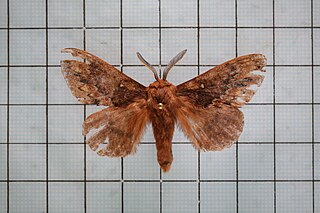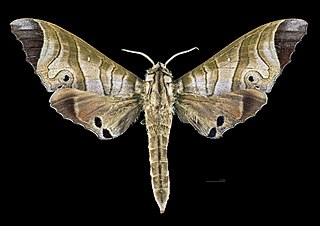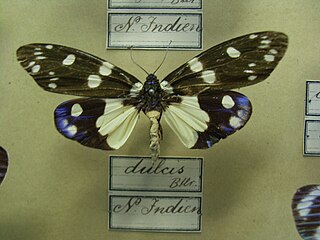
The Thyatirinae are a subfamily of the moth family Drepanidae with about 200 species described. Until recently, most classifications treated this group as a separate family called Thyatiridae.
Lithosia is a genus of moths in the family Erebidae. The genus was first described by Johan Christian Fabricius in 1798. Species are cosmopolitan.

Karenkonia is a monotypic moth genus in the family Lasiocampidae first described by Shōnen Matsumura in 1932. Its single species, Karenkonia taiwana, described by the same author in the same year, is found in Taiwan.
Pachypasoides is a monotypic moth genus in the family Lasiocampidae described by Matsumura in 1927. Its single species, Pachypasoides albinotum, described by the same author in the same year, is found in Taiwan.
Syrastrenoides is a monotypic moth genus in the family Lasiocampidae erected by Matsumura in 1927. Its single species, Syrastrenoides horishana, described by the same author in the same year, is found in Taiwan.

Acosmeryx formosana is a moth of the family Sphingidae. It was described by Shōnen Matsumura in 1927. It is endemic to Taiwan.

Marumba saishiuana is a species of moth of the family Sphingidae.

Eterusia aedea, the red slug caterpillar, is a species of moth in the family Zygaenidae. It was described by Carl Linnaeus in his 1763 Centuria Insectorum. It is found in Sri Lanka, India, Taiwan, Japan and China.

Calliteara lunulata is a moth of the family Erebidae. It is found in the Russian Far East, Japan, China and Taiwan.

Radhica flavovittata is a species of moth of the family Lasiocampidae. It is found in India and Taiwan.

Tethea consimilis is a species of moth of the family Drepanidae first described by Warren in 1912. It is found in Asia, including the Russian Far East, Japan, Korea, Taiwan, Myanmar, Indonesia and India. The habitat consists of various types of mixed and broad-leaved forests.
Eilema formosicola is a moth of the subfamily Arctiinae. It was described by Matsumura in 1927. It is found in Taiwan.

Eilema ranrunensis is a moth of the subfamily Arctiinae. It was described by Matsumura in 1927. It is found in Taiwan.
Euterpnosia is a genus of cicada native to the island of Formosa, the Ryukyu Archipelago, Japan, Hainan and mainland Asia - China, Bhutan, Nepal and Vietnam. The type species is Euterpnosia chibensisMatsumura, 1917.
Tigrioides dimidiata is a moth in the family Erebidae. It was described by Matsumura in 1927. It is found in Taiwan.
Apha floralis is a moth in the family Eupterotidae. It was described by Arthur Gardiner Butler in 1881. It is found in Nepal.
Artaxa angulata is a moth of the family Erebidae first described by Shōnen Matsumura in 1927. It is found in Taiwan, Myanmar, India, Pakistan, Sri Lanka, Malaysia, Singapore and Indonesia.













